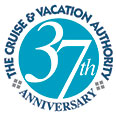Stretching a Ship
By Ted Walker
Learn how cruise ships are expanded and refurbished to create better, more spacious vessels.
As cruise lines compete more fiercely for business each year, they seem willing to do just about anything to offer the most innovative and entertaining on-board experiences that technology will allow. From ice-skating rinks to rock-climbing walls and oceangoing planetariums, bigger is better in the world of cruising.
While brand-new vessels packed with the latest entertainment packages and amenities crowd the oceans, Royal Caribbean steered one of its existing ships on a different course. It stretched the Enchantment of the Seas.
Stretching a large cruise ship is every bit as complicated and impressive as it sounds.
With the cooperation of shipyards, shipbuilding specialists and engineers, Royal Caribbean literally cut the Enchantment of the Seas in two and inserted a whole new section in between. Added to the cruise ship were 151 staterooms, two high-arching suspension bridges, various enhanced public areas, bar and restaurant upgrades, and gravity-defying bungee trampolines overlooking the ocean. These improvements amounted to a quick and cost-effective way to bring the eight-year-old ship up to the escalating standards of today's megaships and in line with Royal Caribbean's quickly improving fleet.
Preliminary planning and design for the project began several years ago. Peter Fetten, vice president for design and new building at Royal Caribbean, played an integral part in the project, which he called at the time "the most important that we have." Fetten's role included guiding the project's initial planning, from budget and design to managing overall progress and risk-analysis. With several decades of experience working with more utilitarian container ships and freighters in German shipyards, Fetten's task has been to advance the branding goals of the Royal Caribbean's growing line while orchestrating a complex and time-sensitive engineering feat.
Though he has coordinated the stretching of several container ships, until this summer Fetten had not faced "a challenging one like this," he says. He notes that what made this project so unique was how quickly it had to be carried out. Every day that a cruise ship as large as the Enchantment of the Seas goes without passengers presents a sizeable cost for the cruise line. With the stakes so high, there must be precise and detailed planning long before the ship is ever taken out of the water.
Fetten and his team of engineers, together with the engineers and technicians
at various shipyards, mapped out every movement that the cruise ship and its pieces would make in the several months that it was out of service. Every pipe, cable and duct that would be cut and reconnected was accounted for.
Finnish shipyard and cruise ship-lengthening veteran Aker Finnyards laid the keel for the new 73-foot, 2,500-ton midbody section in Turku, Finland, in early January 2005. Then the midbody made a three-day journey atop a barge to the Keppel Verolme shipyards in Rotterdam, Holland.
At Keppel Verolme, engineers and workers floated the Enchantment of the Seas into a specialized graving dock alongside the midbody's barge. As water drained from the dry docks, the Enchantment of the Sea's aft came to rest on traditional dry-docking blocks, while its fore sat on a set of massive gliding skids, ready to move forward once the cruise ship was cut in half. The new midbody section was carefully placed beside the ship exactly where it was to be inserted. It rested on hydraulic jacks that held it eight meters off the dock's floor.
Engineers determined the exact "cutting zone," emptying the cruise ship's cabins and public spaces in that area down to the bare steel framework. Fetten and his team carefully selected the most appropriate cutting line. Their goal was to preserve as much speed and efficiency as possible in the lengthened cruise ship when it sailed. In fact, the extended Enchantment of the Seas was expected to lose just 0.2 knots of speed and, according to Fetten, its maneuverability would be as good or better than before the lengthening. Mechanical improvements to the cruise ship included an increase in the bow thruster output, as well as alterations to the rudder and rudder forces. The Enchantment of the Seas now sails much as she did before, and the ship's captains required only "regular and expected training" to operate it, says Fetten.
Once the cutting zone was cleared out, or "freed," the cruise ship was cut with burners, and the fore moved forward on the gliding skids. The midbody, lowered from its hydraulic jacks, was then slid into place between the original sections. The fore was then moved backward into place to complete the massive jigsaw puzzle. Then the body pieces were welded back together and the wiring, pipes and cables were reconnected and reassembled.
According to Fetten, the Enchantment of the Sea's "good structure and strong backbone" made her a viable candidate for stretching. Its existing public spaces were plentiful enough to allow for a manageable integration of new cabins and expanded dining and entertainment facilities.
The final result, after interior and exterior refurbishment projects, is a longer, more spacious Enchantment of the Seas that is better equipped to meet the increasing consumer demands of the competitive cruising industry.
While stretching a cruise ship is still somewhat rare, it is not a new practice. Royal Caribbean and Aker Finnyards (then under a different name) lengthened the Song of Norway by 85 feet in 1978, followed by the Nordic Prince in 1980. Aker Finnyards even lengthened a ship as far back as 1948 in its Helsinki yard.
Costa Cruises also has lengthened several vessels in its fleet, transforming the Costa Europa (formerly Holland America's Westerdam), the Costa Classica and the Costa Allegra, which began its cruising life as a shorter, decidedly more utilitarian cargo ship before its lengthening and refurbishment in 1990. Norwegian Cruise Line stretched the Norwegian Wind, the Norwegian Majesty and the Norwegian Dream as a part of its expansion in the late 1990s.
Royal Caribbean's engineers and captains tested the Enchantment of the Seas's new specifications in cruise ship simulators in Florida, where they can digitally re-create the ship's maneuverability characteristics, as well as any ports that the ship might visit. The entire decommissioning process took only a fraction of the two to three years necessary for building a new cruise ship. And at a cost of $55 million to $60 million, the lengthening project presented a considerable savings over the nearly $800 million that it cost to complete, for example, the line's newly built Freedom of the Seas.
"This is the most challenging project that I've been a part of," says Fetten of the Enchantment of the Seas lengthening. "To get this puzzle together has been a long process."
The lengthened and enhanced Enchantment of the Seas is now wrapping up a season of weeklong Canada and New England sailings out of Boston. Soon it will move south and, starting Oct. 10, begin four- and five-day western Caribbean cruises from Fort Lauderdale, FL. New on-board amenities include bungee trampolines that safely sling those who dare high into the air above the ocean. There is a new Splash Deck with interactive fountains and water jets, and two new suspension bridges span a revitalized pool area.
As for restaurants and nightlife, the ship will offer Royal Caribbean's hallmark Boleros Latin lounge, a new Latte'tudes coffee shop and an improved bar area on the pool deck. Other refurbished areas include the main dining room, shopping area, casino, jogging track, fitness facility, day spa and art gallery.

With each issue of Ultimate Experiences Online, you’ll enjoy a collection of articles, slideshows and videos that we will inspire you to make your travel dreams a reality.

To help you discover ways to explore the world, we're pleased to share our The Travel Magazine Online.
 Save money and escape the crowds. Hot Deals and multi-port packages. Savings of up to 50%!
Save money and escape the crowds. Hot Deals and multi-port packages. Savings of up to 50%!

Our free app that allows you to carry all of the destination information you need while traveling, right in your pocket!

We recommend optional travel insurance that protects you in the event of having to cancel your trip avoiding travel vendor cancellation policies and more!





